Sergeant William
Henry Avery
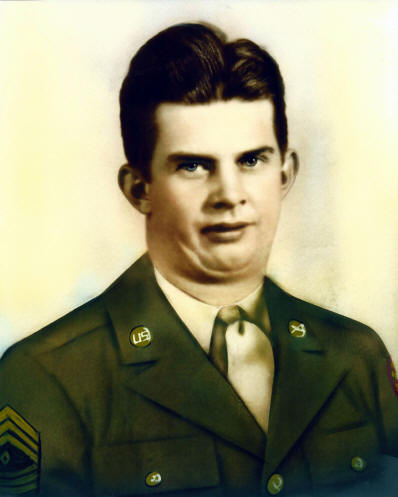
Sergeant William Henry Avery
was born on 23 Oct 1915 in Quincy, Adams, Wisconsin, as the first child of John Barlow Avery and Herta Anna (Wegert).
I present a family war hero.
by Jerry Dean Swanson
William enlisted in the Army four days after his 27th birthday.
Assigned to the 22nd Infantry Regiment, 4th Infantry Division, he was soon shipped to Great Britain to prepare for the D-Day Invasion. His division landed at Utah Beach, and was tasked to destroy the big gun emplacements there. They soon headed for Belgium and were eventually the first US Army Division to enter Germany. There, the regiment was involved in the Battle of the Hürtgen Forest, which is still the longest single battle the Army has ever fought in its history.
During this battle, on 22 Nov 1944, the day before Thanksgiving, William was killed in action.
He was buried in a temporary grave at Henri-Chapelle, but by the end of the war, he was moved to his present location at the memorial at Liege, Belgium (Henri-Chapelle American Cemetery and Memorial). Plot: C, Row: 3, Grave: 1.
He had lived in Quincy, Adams, Wisconsin, where he and his wife, Genevieve (Dick), had a son, William John Avery II, who was born on 02 Feb 1942. William junior was only about three years old when his father was killed.
Thank you for your service William!
William was my 1st cousin, 1x removed.
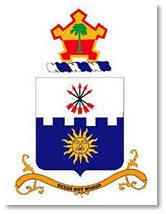
Deeds Not Words
The motto of the 22nd Infantry Regiment
The 22d Infantry Regiment was stationed at Fort McClellan, Alabama, as a component of the Eighth Infantry Brigade, which was the sole active component of the deactivated 4th Infantry Division. The 22d Infantry Regiment moved to Fort Benning on February 21, 1941 to train with the division, and then moved to Camp Gordon, Georgia on December 27, 1941, where it was reorganized under a motorized TO&E (Table of Organization and Equipment) on September 9, 1942.
The regiment moved to Fort Dix, New Jersey on April 16, 1943, where it reorganized under a regular infantry TO&E on August 1, 1943. The regiment continued to train for combat, moving on to Camp Gordon Johnston, Florida on September 28, 1943, and to Fort Jackson, South Carolina on December 1, 1943.
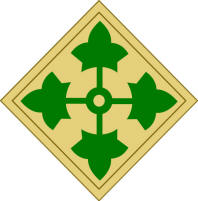
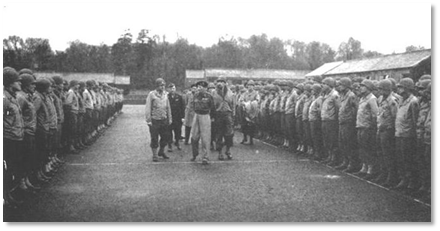
Field Marshall Sir Bernard Montgomery inspects the 22nd Infantry Regiment in England April 27, 1944. William H. Avery is probably in this photo!
The 22nd Infantry Regiment subsequently got its Port Call orders, and staged at Camp Kilmer, New Jersey on January 8, 1944 until it shipped out from the New York Port of Embarkation on January 18, 1944.
The regiment arrived in England on January 29, 1944, settled in near Plymouth, England, and started preparations to D-Day. **Although these photos may not be of William, they are from these battles, and are photos of his regiment, and he was there somewhere.
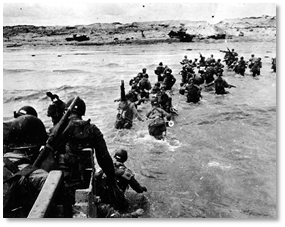
Utah Beach Landing on D-Day
The regiment assaulted Utah Beach on June 6, 1944, as part of VII Corps in the D-Day Invasion, and arrived near Pavenoville, France by the end of D-day. It then participated in the Cherbourg Peninsula operation while attached to Second Armored Division from July 19 through August 2, 1944.
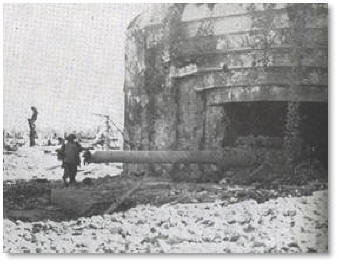
280mm gun in fortification at Crisbeq, taken by the 22nd Infantry
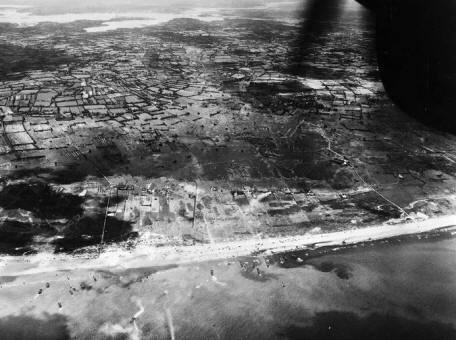
Aerial photo of Utah Beach
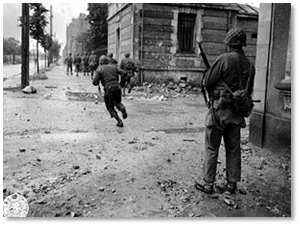
A soldier of the 22nd dodging enemy fire on the streets of Cherbourg.
The regiment then returned to Fourth Infantry Division and headed for Belgium. As part of Operation Cobra, the regiment moved into Belgium on September 6, 1944, and entered Germany on September 11, 1944.
At this point, the regiment was deeply involved in The Battle of Hürtgen Forest, the name given to the series of fierce battles fought between U.S. and German forces in the Hürtgen Forest.
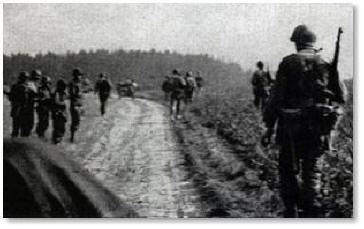
Nearing the Siegfried Line, September 1944
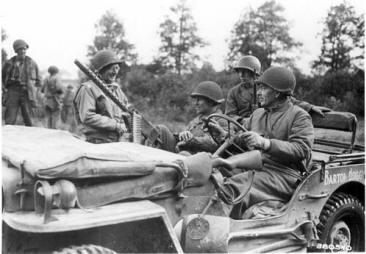
12 September 1944, COL Lanham CO 22nd Infantry Regiment, 4th Division (the first Army unit that entered Germany) talks withMAJ. GEN. Raymond O. Barton, C.O. 4th Infantry Division and the first US General inside Germany.
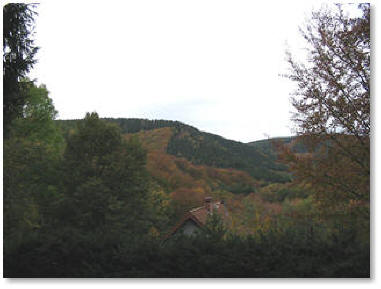
The Hürtgen Forest
The forest occupies a rugged area between the Ruhr River and Aachen. The dense conifer forest is broken by few roads, tracks and firebreaks; vehicular movement is restricted. In the autumn and early winter of 1944, the weather was cold, wet, and often prevented air support. Ground conditions varied from wet to snow cover.
The attack started on 16 November. The two infantry regiments attacked in parallel columns: the 8th along the northern edge of the forest towards Düren, the 22nd further south in parallel.
The open flanks invited infiltration. William's Company (Item Company was ordered to guard the northern flank as the attack pushed eastward. Similar tactics elsewhere in Hürtgen had "invited disaster".
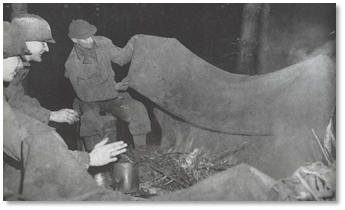
22nd soldiers try to dry out a blanket, Hürtgen Forest,
November 1944
Attacks by the 8th Infantry Regiment on Rother Weh Creek hit heavy resistance and were repulsed with heavy losses. The 22nd failed to take Raven′s Hedge (Rabenheck), beaten back by heavy machine-gun and artillery fire along the firebreaks. After three days, there were 300 losses, including officers and NCOs.
On 20 November, Russell J. York—a medic with the 4th Engineer Battalion—earned a Silver Star in the Weisser Weh battle when heavy shelling hampered efforts to install a bridge.]
Responsibility was returned to V Corps and, on 21 November, 8th Division attacked the Weisser Weh valley, continuing toward Hürtgen. The 121st Infantry Regiment hit heavy defenses immediately.
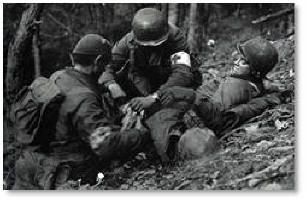
4th Division medics treat a wounded Soldier in the Hürtgen Forest
By 18 November, tanks were essential, so engineers blasted tank routes through the forest. Communications and logistics remained a problem, so the next day the attack paused to allow re-supply and evacuation of the wounded. German reinforcements arrived from 344th and 353rd Infantry Divisions and resistance stiffened further.
Despite armored support from the 10th Tank Battalion, daily advances were less than 600 yards. Hürtgen was taken on 29 November and the battle continued to Kleinhau, 1 mi (1.6 km) north. This battle became the longest battle on German ground during World War II, and the longest single battle the U.S. Army has ever fought in its history.
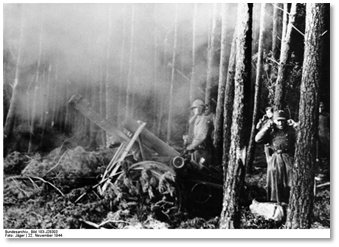
A German heavy-infantry gun firing in defense of a U.S. attack
on 22 November 1944 in the Hürtgen forest.
Item Company (William's) reported heavy German artillery casualties. I am guessing William might have died in these shelling tactics used in that battle. That of exploding the shells at tree-top, thus not only showering down shrapnel, but also the exploding trees.
The 4th Division was so badly affected by casualties, it had to be pulled from the front lines to recover and rebuild. The 22nd Infantry Regiment sustained the highest number of casualties of any single Regiment involved in the campaign. Estimated figures for the 22nd Infantry were put at 2,678 casualties of all types. This included 233 killed and 1,730 wounded. These casualties were incurred during a period of 18 days.
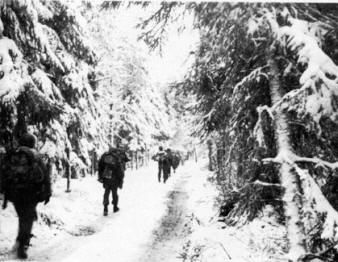
The Hürtgen Forest cost the U.S. Army at least 33,000 killed and incapacitated, including both combat and noncombat losses; Germans casualties were 28,000.
During this campaign, William was killed,
on Wednesday, November 22, 1944.
Sergeant William Henry Avery
4th Infantry Division
22nd Regiment
3rd Batallion
Item Company
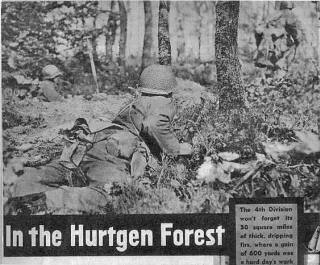
From December 3–7, 1944, the regiment was attached to the 83rd Infantry Division, and returned to Fourth Infantry Division in Luxembourg on December 12, 1944.
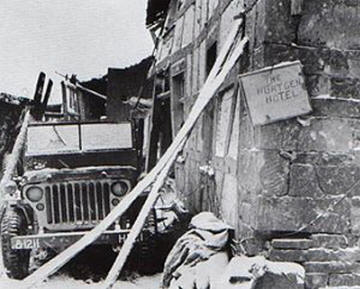
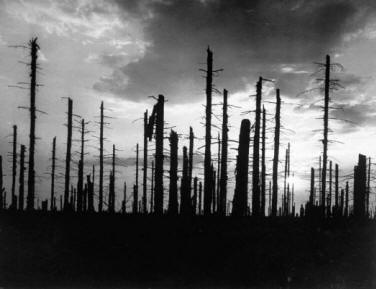
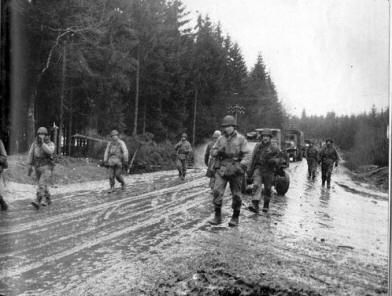
My Father, William Henry Avery
By William John Avery
"I never knew my father. As my life was barely starting, his life, like so many other men and women, ended because of man's inhumanity to his fellow man. I have often wondered what my life would have been like, had he not been taken at so young an age. Would I be blessed with such a wonderful family, four great children and my lovely wife? Would I be successful or unsuccessful? Would he be proud of me as his son?
These are questions that cannot be answered, but because of his sacrifice and the sacrifice of this country's young men and women, these opportunities have been afforded me. This wonderful place of remembrance to the honor and memory of this nation’s prime manhood and womanhood is personally a connection to my father.
Although he rests in Belgium, I can now commune with his spirit, feel his presence; pay my honor to what he and so many others did to keep America free. This place has bridged a gap between a cemetery in Belgium, sometimes I hope to visit place, to a site that will be hallowed to me, because I know that my father's spirit will meet and welcome me here, whenever I choose to or need to come."
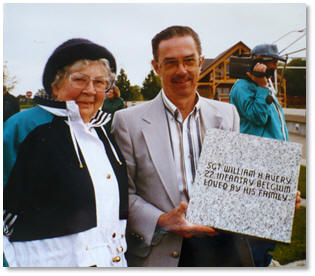
William John Avery, and William H Avery's sister,
Ellen Louisa (Avery) Wintersteen, took part in the dedicationof a Legacy Stone at The High Ground, the WWII Memorial, in Neillsville, WI in 1998.

The War Memorial in Neillsville, WI
Dedicated in 1993, the stainless-steel globe represents the broad reach of the conflict and the world's involvement in this war, which touched every continent in some way. Stained glass campaign ribbons are mounted in their appropriate locations representing the various theaters of action. The globe measures five feet in diameter and is illuminated from the inside at night.
The granite base on which the globe rests is four-sided. One side displays the "Kilroy was here" imagery and story; another is emblazoned with the "Ruptured Duck" emblem. The remaining sides list the major battles fought in the Pacific and European Theatres.
The surrounding area is dedicated to World War II and includes a picnic area, a grassy area for events, and a raised area for a future World War II Wall.
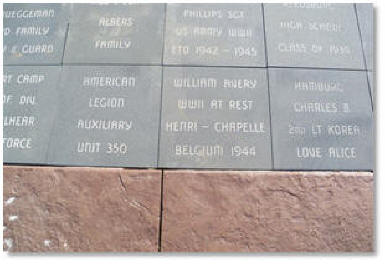
The William Avery Family had a picnic at the Veteran’s Memorialin Reedsburg, WI in September 2011. A memorial stone was purchased for both
William Avery and Paul Derby.
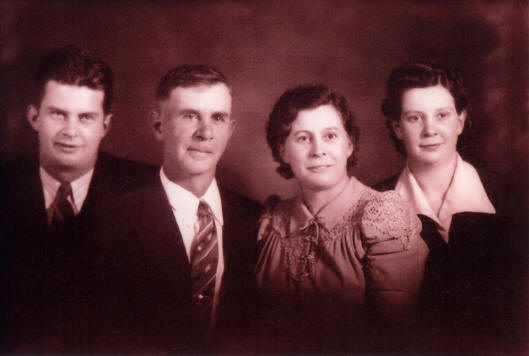
The Avery Family
William Henry, John Barlow, Herta Anna (Wegert),
and Ellen Louisa Avery. This photo was taken just before William left for the service.
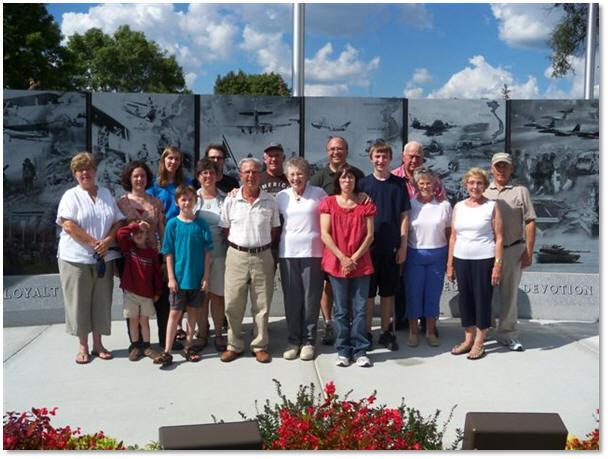
The William Avery Family at the Reedsburg, WI
Memorial, September 2011.
Left to Right: Carol Wormet, Soren Clutter, Nicole (Avery) Clutter, Tina Majinski (Nathaniel Avery's friend), Jasper Clutter, Shellie (Avery) Boldt, Nathaniel Avery, William Avery, Ronald Wormet, Donna (Wormet) Spaeth, Tom Boldt, Debbie (Avery) Schiesl, Zachary Boldt, Thomas McManamy, Dorothy (Wormet) Franczyk, and David Franczyk.
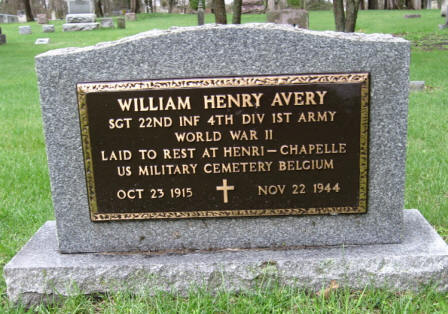
Honorarium
Quincy Cemetery
Friendship, Adams County, WI
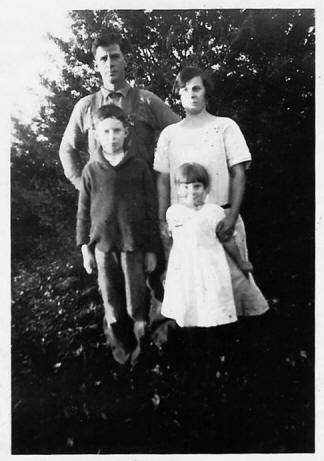
The Avery Family
John and his wife Hattie (Herta Anna Wegert),
with their son William and daughter Ellen
About 1923.
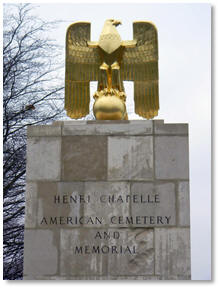
William Henry Avery rests at the Henri-Chapelle American Cemetery and Memorial in Belgium. The memorial covers 57 acres, and rests 7,992 of our military dead, most of whom lost their lives during the advance of the U.S. armed forces into Germany.
Their headstones are arranged in gentle arcs sweeping across a broad green lawn that slopes gently downhill.
A highway passes through the reservation. West of the highway, an overlook affords an excellent view of the rolling Belgian countryside, once a battlefield.
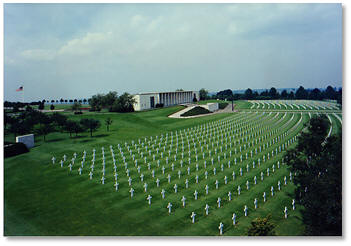
We are fortunate of Larry Swanson’s friendship with Brigitte Watenpaugh and Cecil (CC) Corbin. They live in Williamsburg, VA, and have a son going to school in Brussels. Larry and CC have been friends since the 70’s, when Larry and he were stationed in Brussels.
One day, Larry and I were discussing William’s Military Service and that he was buried at the memorial in Belgium. Larry thought of his friends and decided to ask them if they might visit the site for pictures when they visited their son on their next trip there.
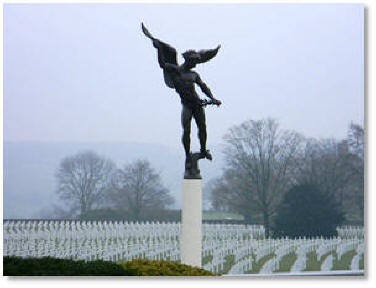
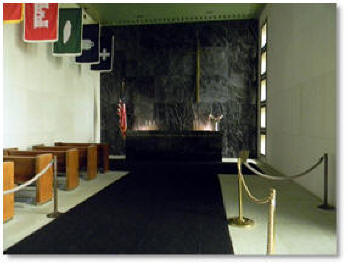
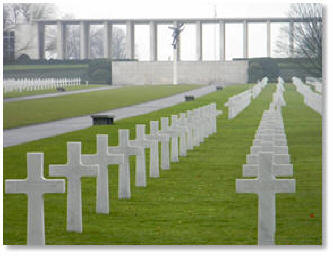
Honoring William Henry Avery
By Brigitte Watenpaugh and Cecil (“CC”) Corbin
When we arrived in the train station, the station manager called the cemetery and they sent a car to pick us up and take us there. Bobby Bell, the Superintendent of the cemetery, gave us a tour of the place and then
took us to his office where we met with Caroline Oliver, the cemetery associate.
Caroline asked us whom we were there to visit, and she then pulled William’s file. Caroline has been working for the past 10 years to put together a file on each soldier along with any information she can find on everyone. She was able to tell us that we were the first people to visit his site. We filled out a paper saying that we had come to visit at the request of Larry. In the future, everyone will know who we were and when we came.
She was able to tell us that he died in the area during the war and that he was originally interred at Henri Chapelle. During the war, the soldiers were brought there from surrounding areas and buried in a temporary cemetery. Some soldiers were from the battle in the Hürtgen Forest. This is the area where Henri Chapelle is located and where Sergeant Avery was killed."
William’s original location at the temporary cemetery was BB-5-83. After the war, when the official cemetery was going to open, William’s family members were asked if they wanted their soldier to be sent home, or to remain buried overseas. The family chose to have him remain in Belgium. He was moved to the new permanent location, which is now Plot C, Row 3, Grave 1.
"We also found out that on Sept 23, 2010 a woman named Mme. Annie Paquet, who lives in the area, adopted his grave. She visits the gravesite.
Caroline also recommended that you read "Hell in Hürtgen Forest", ISBN 0-7006-1360-9. It is a book written about the 22nd Regiment 4th Infantry Division and their battles in The Hürtgen Forest.
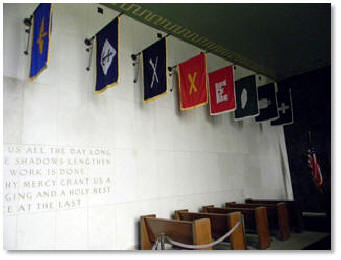
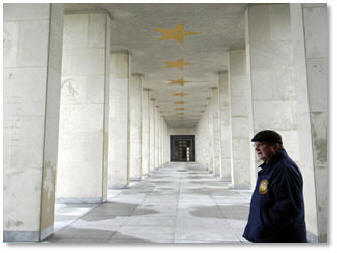
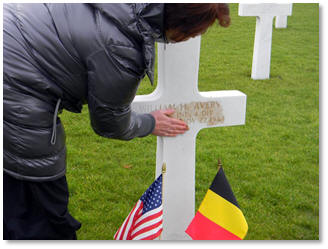
Caroline rubbing sand from Normandy Beach
into William's headstone.
After getting some further information, Carolyn took us to his site, where she placed the flags and then wet some sand from Normandy Beach and rubbed it into his headstone. I can only say that although he was not our relative, it was very moving, as it was a veteran.
She then left us to be with him and we walked the cemetery and just enjoyed the moment and the day. When we left, we took the flags. We will be sending them to the family.
When Larry asked us to do this, we thought we would just be visiting a cemetery and in no way were we expecting anything like what we got, both in terms of information and in terms of the feelings we experienced. Thank you for
asking us to do this.”
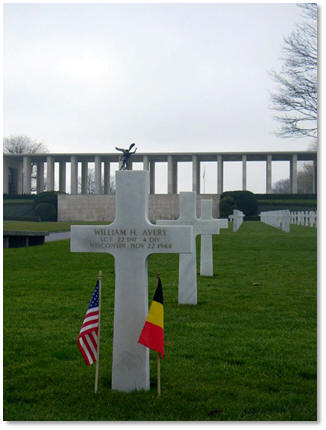
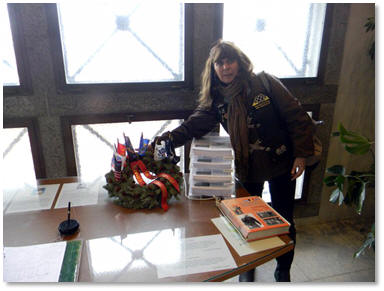
“They wanted me to pass on a thank you to the "Patriot Guard Riders"and "Wreaths across America" for all that they do. This is one of the wreaths from WAA.”
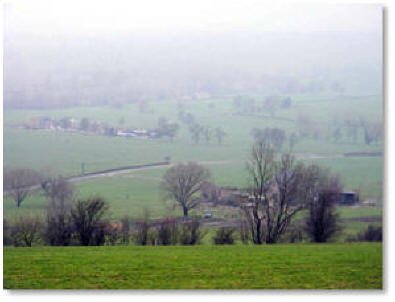
A view from the Memorial
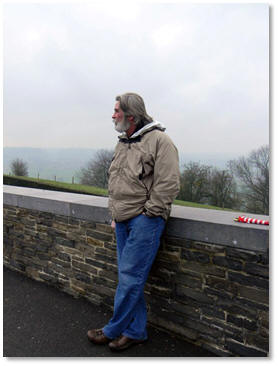
CC reflecting on the moment
The Story of This Yellow Rose
"Yesterday, a 7-year old Belgian boy, who has become fascinated with Americans, had his grandfather bring him here and he randomly put a yellow rose on six graves.”
On her return to the USA, Brigitte brought back the various materials, and the flags presented to them by the memorial staff, to be given to William’s family.
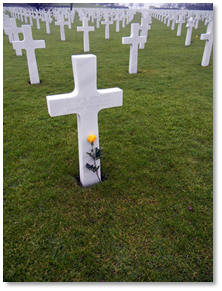
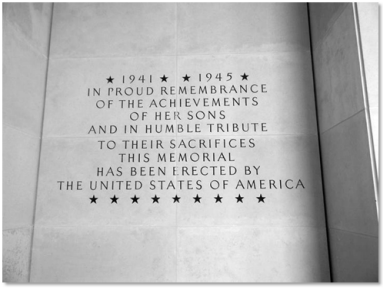
Thank you for your Service William!
Never Forget!